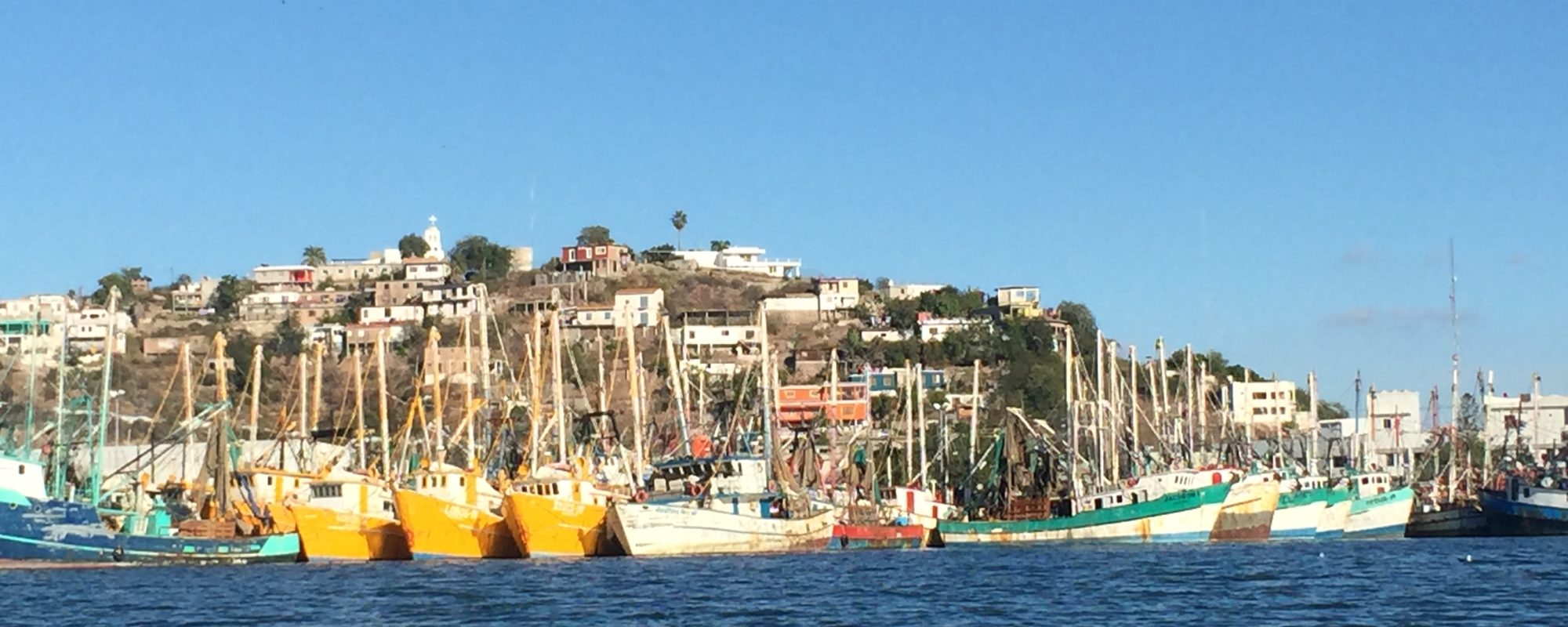‘Its beauty has been compared with the Greek isles,’ the guidebook waxed—followed by the incongruous statement that Topolobampo is primarily a cargo port.
“Sounds good to me,” Jon said with a grin as we sat around the table on Oleada, discussing our trip through 400-plus nautical miles of coastline mostly unexplored by sailors. Beginning from our dock in industrial Guaymas, we hoped to make four long overnight passages spanning the states of Sonora and Sinaloa. With our friends Jon and Shannon, a young, spirited, and good-natured couple from Berkeley aboard their 33-foot sailboat Prism, we were headed down the coast with poor charts and a guidebook renowned for its inaccuracy. We couldn’t find any information online or in the sailing community about this passage—everyone avoided it.
This is the side of the Sea of Cortez that makes headlines like “El Chapo Captured in Coastal City of Los Mochis,” not so much for pristine aqua waters and the tourism therein. Sailors in Guaymas shook their heads, mystified that we would traverse this coast, with its long passages and colder water.
With sailboats a rarity, we didn’t know how we would be received: with stares and scoffs, or with smiles and warmth.
We couldn’t have imagined our upcoming interactions—or the way that fishermen would open their boats and minds to us, sharing a hidden local secret about the globe’s rising waters.
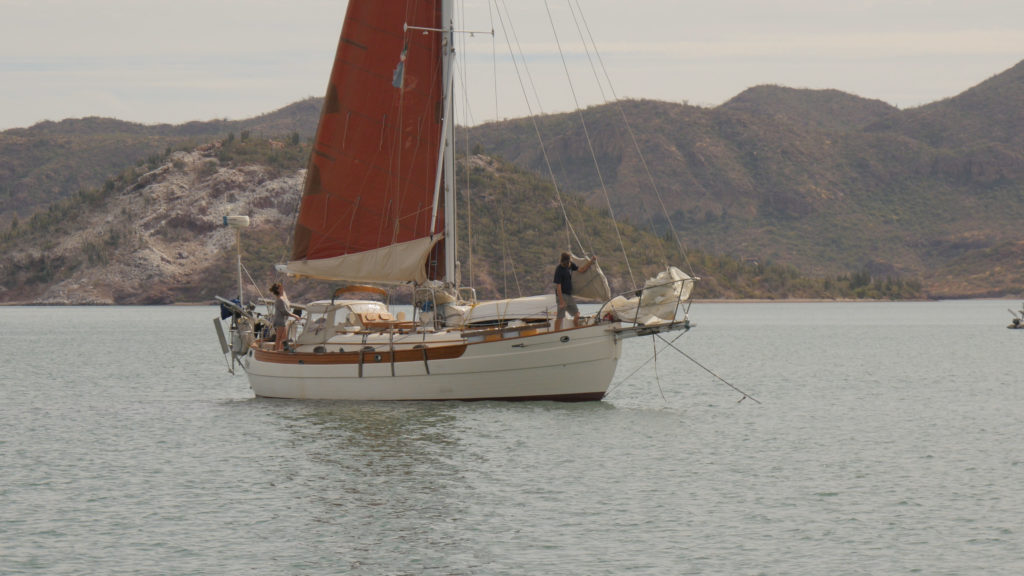
***
We departed the rocky desert hills of Guaymas a couple of hours behind Prism. Safety in numbers especially applies when sailing: having another couple with knowledge of sailboats in radio contact reassured us. We knew we could call them if there was any trouble.
Which, of course, there was. The sea had been stirred by weeks of north winds into steep, choppy swell that hit us on the side every six seconds, battering the boat around like a cat toy. At around 9pm, the boat stopped cold at the top of a tall wave, throwing me forward as a wave drenched me from the starboard side. We had been traveling at over six knots, and although we couldn’t hear the impact over the wind and water, Josh leaped up to search for a possible hole. The impact felt dull, possibly a dead sea lion or a whale surfacing. Josh moved like lightning around the boat, clipped in to the jack lines, checking for a hole while I shook at the wheel, impossibly seasick and terrified for our boat. After checking the bilge a few times, he determined that we weren’t taking on water, but we called Prism ahead of us to tell them the story in case our situation changed. We set the autopilot again and I curled around our bail bucket, a position I maintained for the rest of the night.
We arrived the next morning at the long, protected curve of tan sand, Bahía Santa Barbara, escorted by dolphins surfing the swell. We stayed a few days to rest.
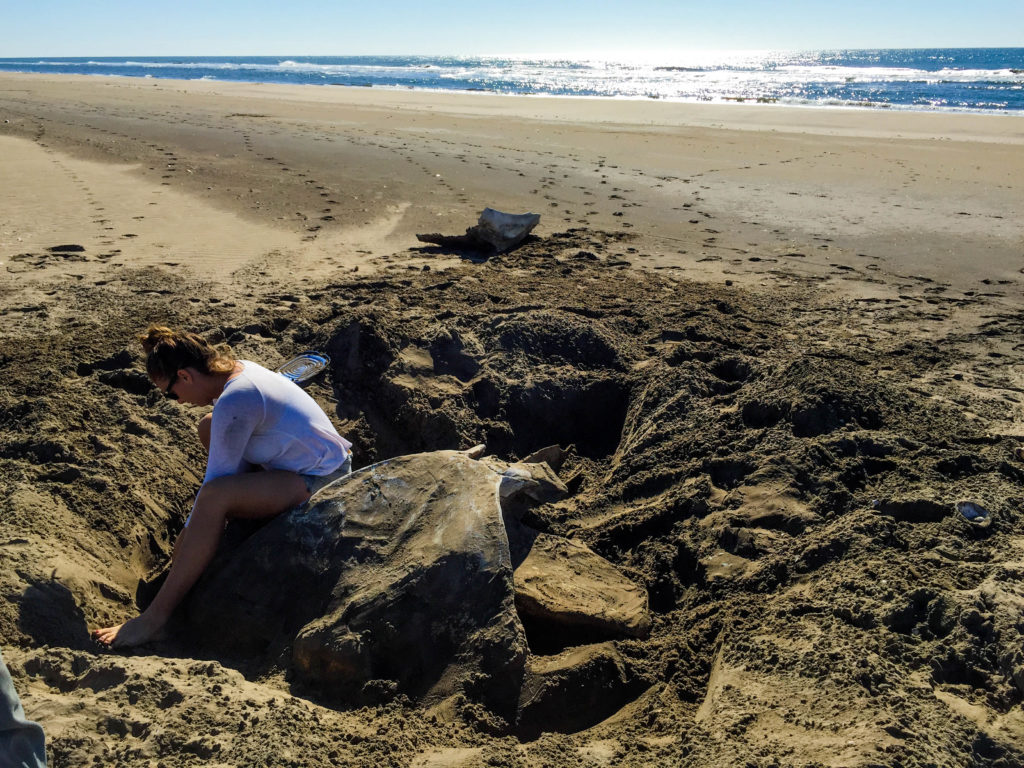
I soon realized that my persistent seasickness meant I had carried a stomach bug with me from Guaymas. Even though I still couldn’t eat, gentler seas ushered us toward Topolobampo and the bucket and I stayed on opposite ends of the cockpit.
As morning broke and we emerged from our night passage to Topolobampo, a panga approached us six miles offshore. On our sailboat, we are uniquely both safe and vulnerable—we know our boat well and can move away from problems on the shore, but if we meet with unfriendly visitors offshore, we are far from help. We see many trawling shrimp boats and pangas over the water, but the quick, angular turn that signifies that a panga has seen us and is coming our way always quickens my pulse.
As the panga approached, bow high, I could see three heads peering out from the open deck: one at the helm at the back, and two men in the middle. As they swept their boat alongside, I opened my mouth to ask what they wanted—and I watched as the smiling man in the middle held up his black smartphone and took our picture.
A photo! These three men had diverted from their fishing route to capture something that was rare enough to be worthy of a picture. My slight nervousness melted into laughter. The round white light of the flash blinked on the phone and reminded me to smile, and after a pause, the man, satisfied with the photo on his screen, put down the phone. We exchanged small talk (a tough task when our diesel engine is running, even in neutral, and we are sloshing about in the swell and wind,) and they gently maneuvered their panga behind our boat and throttled up into the western horizon.
Normally I am the one taking photos. In a place where curiosity blossomed on both sides of the lens, what other interactions would unfold as we sailed deeper into this coast?
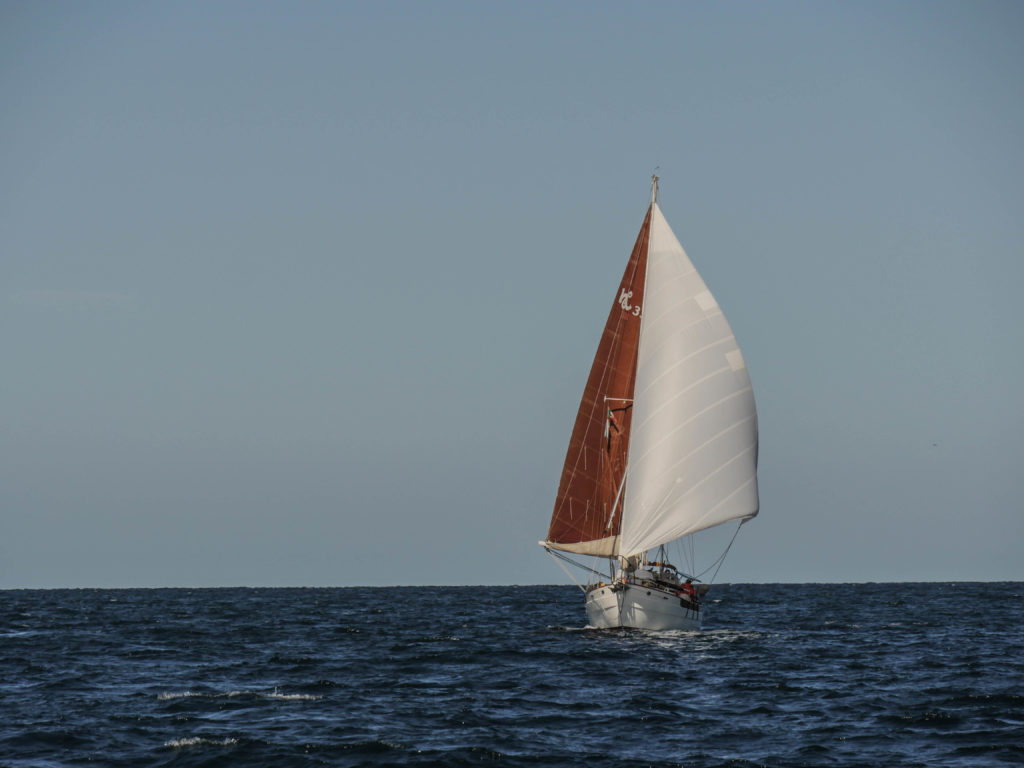
***
In the ‘Greek Isles’ of Topolobampo, it meant every fisherman gave me a piece of his livelihood—the catch.
As we approached the channel, we could see men hauling up lines in pangas. As we passed one panga, one man leaped to his bow when we waved and pumped his fist in a gesture of shared excitement, his muscular shoulders apparent even from a distance. I put the binoculars to my eyes to see their catch. Seeing me do this, he puffed up his chest and gave the international young person’s symbol to rock on: the bull horn shape with a fist, the middle and ring finger curled down and the other three proudly pointed. I laughed and return the gesture, and then he realized why I was looking. He scrambled to the bottom of the boat and lithely jumped back to the bow, holding a giant vermillion-colored snapper high over his head, weighing maybe over 20 pounds. Josh and I cheered as the wind carried us on.
After much confusion perusing our conflicting charts, Josh and I decided to follow the long and well-marked channel through the rompientes, the breakers that guard the hidden entrance to Topolobampo. We passed shrimp boats and cargo ships to find the peninsula that noses steeply into Ohuira Bay. Colorful houses clung to the steep, scrubby hillsides of the tiny town. After we anchored next to Prism, pangueros sped through the narrow space between our sailboats, curiously peering onto our decks and enthusiastically waving when we would give long, big waves from the cockpit (sometimes the only way to be seen on the water is to exaggerate and slow down movement.) If pangas approached slowly, I moved to the rail of our boat to show that we wanted to talk.
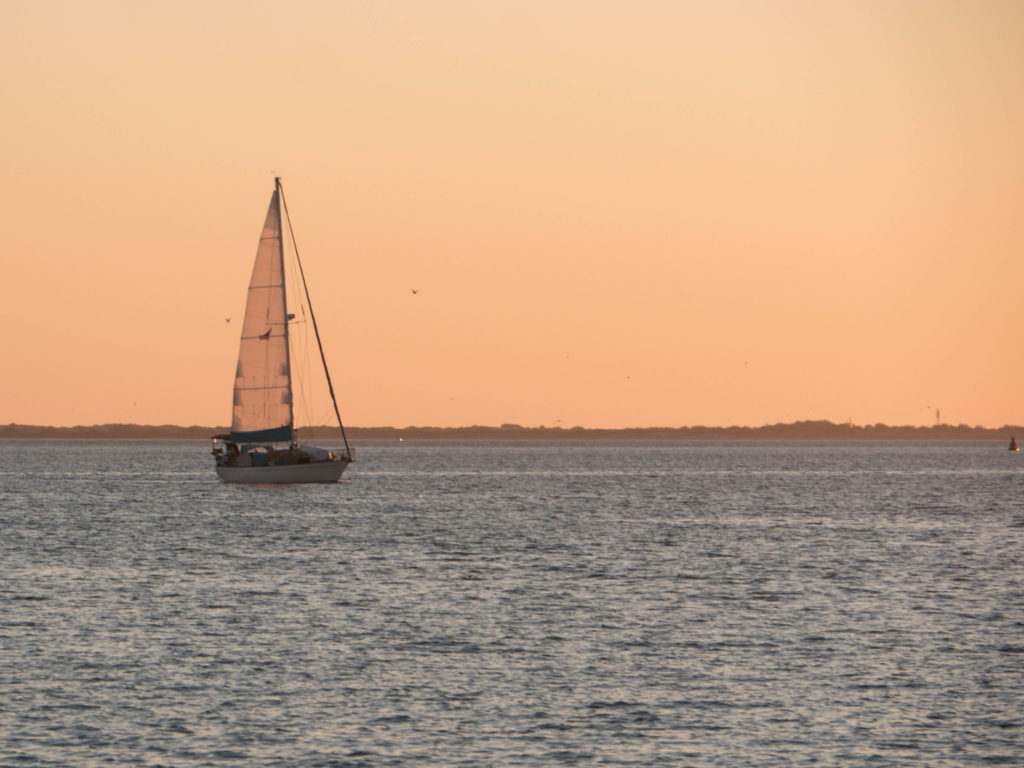
Antonio and Callo, who had motored by more slowly than the rest, slid alongside in the calm inlet when I stepped to the rail. Antonio stood squarely at the motor, and Callo leaned on his elbow, lying on his side on the flat white bow. Both wore the white rubber boots of panga fishermen, and Antonio wore a grey hoodie with the Saints football team logo. Antonio’s stern expression evaporated into a big laugh when I asked him my first question: are there crocodiles here? (Jon on Prism had just hopped into the cloudy water to look at their hull after they missed a channel marker and immediately ran aground. Their boat was undamaged, but he realized after his quick swim that the surrounding mangroves could possibly be the beginning of crocodile country.) No, no crocodiles here, they said, their eyes twinkling with amusement. They spun their panga to move next to our hull, and with bravado they welcomed us to their town and spoke proudly of their lives. They spoke easily and I peppered them with questions: For what were they fishing? (Snapper.) Were they having any luck? (No.) Did they live here? (Yes.) Were they born here? (Yes—unlike many of the fishermen I met along the Baja peninsula, every fisherman I met on this coast was born in the town in which he fished.) Antonio, who sported a Saints hoodie, had spent 14 years in Louisiana working on a fishing boat before being deported. He relished the chance to use his English with almost desperate enthusiasm.
They told me about their everyday life on the water in Topolobampo: they are on the water by 5am—which we knew from our night sails is a cold time to be on the water. Their lives, and livelihoods, depend completely on the tides: in this shallow bay, they rely on the low tides that leave fish “piled” in the shallows. I asked them if the tides had changed—or what else had changed.
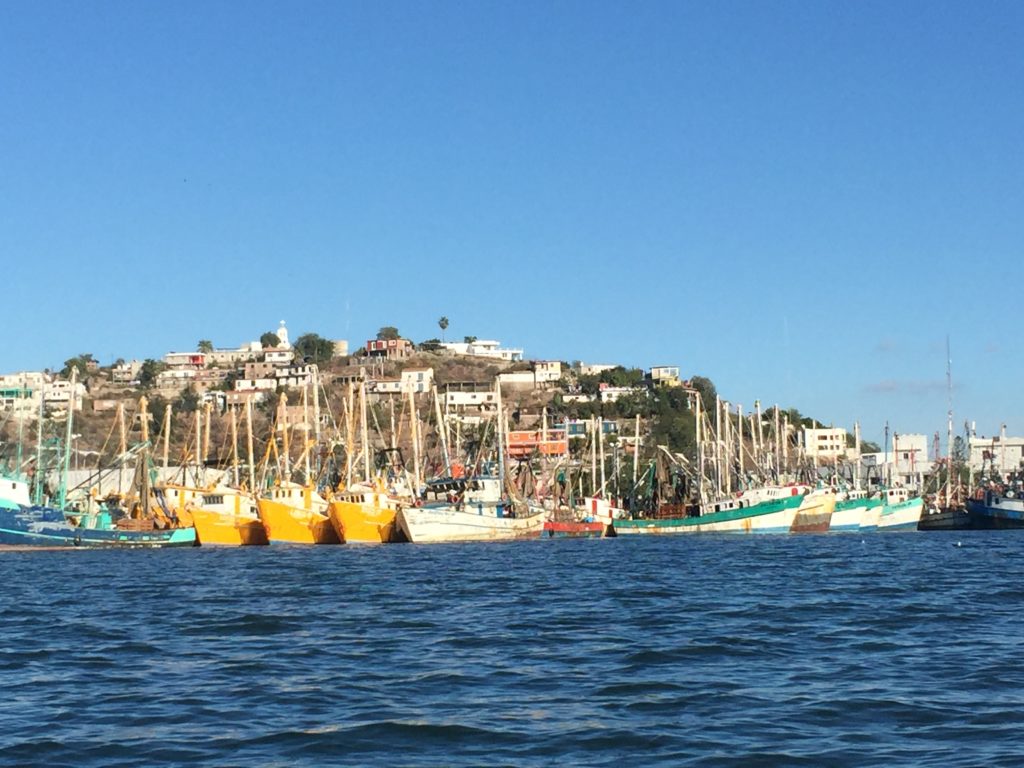
The water is just higher now, they lamented. They can’t get the kind of catches that they used to, even on the full or new moons, when the tidal swing is the most drastic. And, of course, there are far more fishermen these days. Fewer fish, more fishermen is a theme we would hear repeated down this coast. But this was the first time anyone had mentioned higher water—or the direct impact of that higher water on their lives.
Could this be sea level rise? Globally, the oceans have risen an average of 8 inches since 1880. But more alarming than the overall rise is the recent increase in the rate—and the cause. From 1900 to 1993, the ocean rose at about 1.7 milimeters per year, driven by the thermal expansion of gases in water. As water heats up, it expands. And it’s getting that extra heat from the globally rising temperature.
But in 1993, the rate nearly doubled to 3.2 milimeters per year. So what changed? The glaciers. Since 1993, 75 percent of sea level rise comes from land ice melt, whereas it was only contributing 50 percent before. In the future, the magnitude and rate of Greenland and Antarctic sheet ice will determine how much the sea will rise over the next 100 years: from 8 inches to 18 feet.
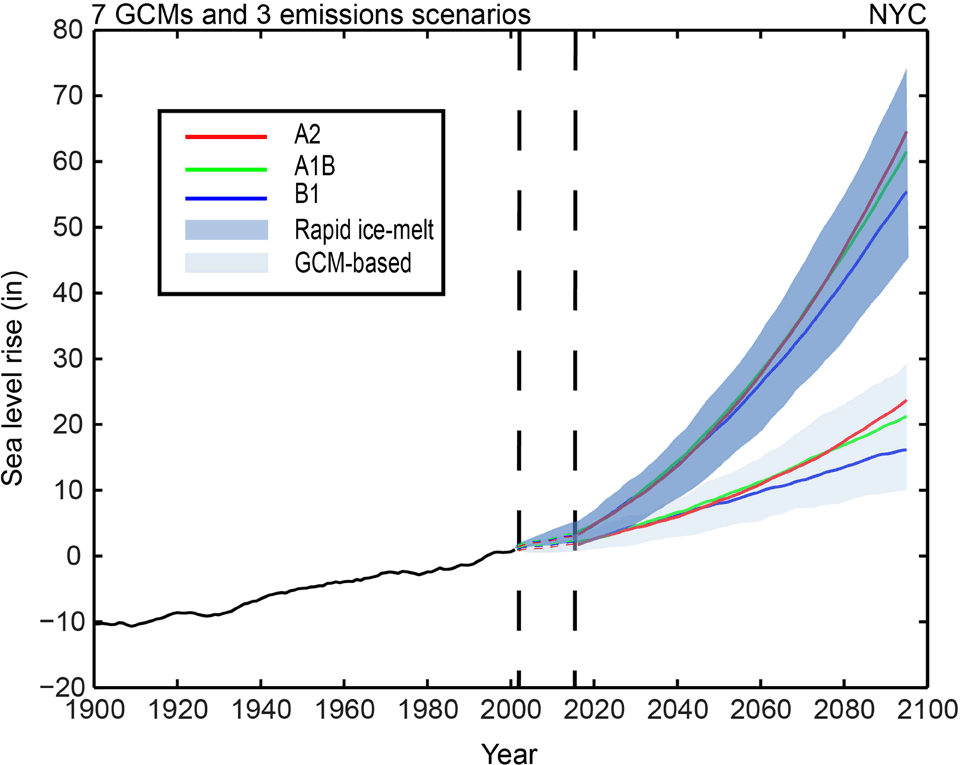
But even small, incremental changes would be felt by the fishermen here—an inch means a significant change in the number of fish that would be trapped, since more could escape with higher water. This was an aspect of sea level rise I hadn’t considered—tidally dependent fisheries.
As I get to know the ocean more intimately, I realize how closely an ocean life is bound to the tides. Tides determine our speed and our passage through many areas. For the fishermen, tides bring upwelling and create currents that bring nutrients to feed the underwater food chain. Here in Topolobampo, they dictated the movement of fish, and therefore the size and consistency of the catch.
Small changes in sea level ripple into big changes in tidal level. Sea level rise is like a filling bathtub—sounds like no big deal. But the damages really start to take place when that water sloshes around in the tub: a little bit of extra water can have an increasingly disproportionate impact as it moves back and forth in the tub. Many places now experience “king tides,” high tides that flood city streets or entire districts to levels previously unrecorded. And higher tides mean higher storm surges—something already plaguing Mexico’s Pacific coast and even caused multiple deaths in Acapulco last year.
What Antonio and Callo told me is that higher water not only affects the land, but the underwater world of bays and estuaries—and the people dependent on them. These lifetime fishermen observed the small changes over time because it affects their source of survival, the fish.
As Oleada and the panga bobbed and clunked together, Antonio continued his jovial banter. He tested Josh’s Spanish and discovered that Josh is not only a fisherman, but that his birthday was the following day. The two men immediately realized that they were suddenly the town ambassadors for bringing the festivities: they passed us their only gift in the panga—a small sea bass lying on the floor—and promised profusely to return with excellent fish the next day. I could tell that fresh fish are the ultimate celebration, the necessary mark of a good birthday here.
But that was only the beginning of our gifted fish. The following morning, while on my paddleboard, I met Davíd, a dark skinned man using a net to pull fish out of the shallow bay adjoining the anchorage. They were lisa, or mullet, a commonly used fish for bait, and that was his reason for harvesting on this calm morning. As I watched him, I felt something I commonly feel when I watch fishers on the water: how can there possibly be enough fish for everyone? Antonio told me there are 500 fishermen in this town alone. The embrace of familial fishing tradition and survival is tight on the water, and I secretly hope for its survival in some, as-yet-unknown, formula of sustainability.
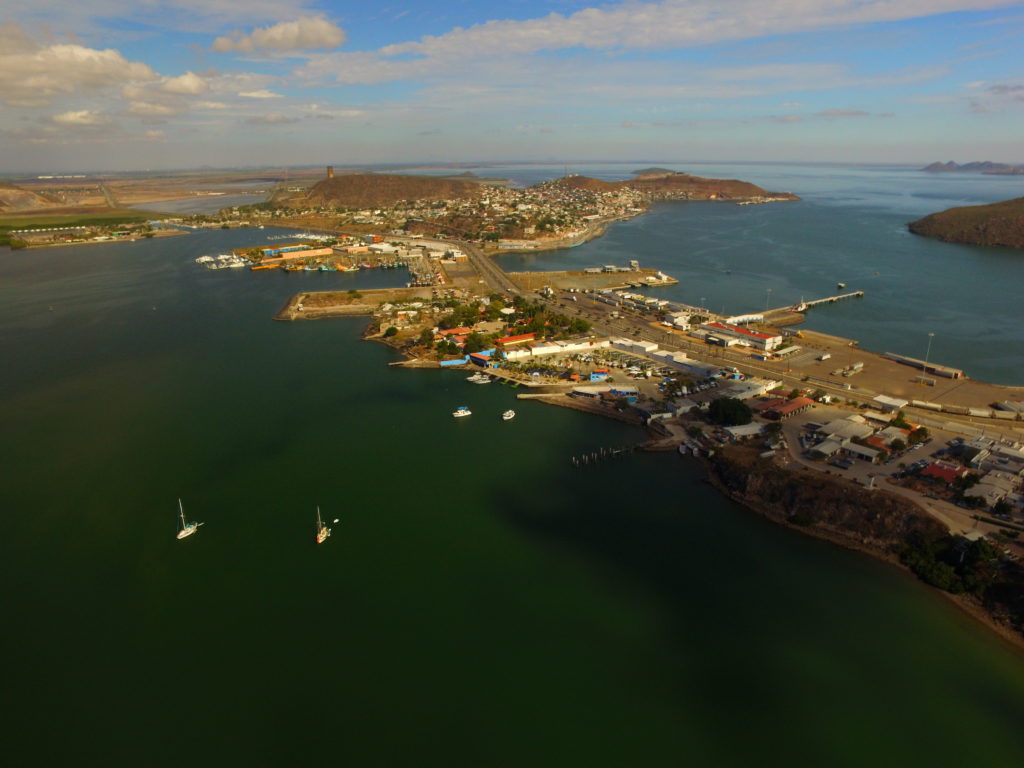
Do you fish? Davíd asked, bringing me back to the wriggling fish on his deck. Yes, but we have had terrible luck, I told him with a smile, which is true. I explained the different plastic lures we use, and he nodded thoughtfully.
You need real fish, he said, and he picked through the mullet on his deck to retrieve the five largest fish.
Really? I hesitated to take his catch. He scoffed gently and handed me the fish. We realized that I couldn’t carry them all on the deck of the board. He smiled and pulled a piece of black string somewhere from the floor of his panga and quickly opened the heads of the fish with a short knife to string them together. As we talked, he told me about the fishing: more water, fewer fish, more fishermen. I thanked him profusely and paddled toward Josh, who has been towing a lure throughout the bay as we paddleboarded.
“How did you catch more fish than I did without even a rod? I think I have to reevaluate my fishing tactics.”
The next day, as we motored into the channel to anchor on the other side of town, Antonio and Callo joined us again on the starboard side.[i] They had planned to travel in their open boat out to the steep Farallon Island, 20 miles out to sea, to fish for a birthday feast for Josh—but they hadn’t caught enough bait. Still, they tracked us down to bring us the largest barracudas they had caught, which Callo assured us would be delicious.
The town of Topolobampo rises steeply from the water, protected from the sloshing, rising sea for now. But the heart of the town, the fishermen, already must contend with higher water. Josh handed the men a plastic ziplock bag, and they stuffed the long, striped fish inside, tail tips poking out of the top.
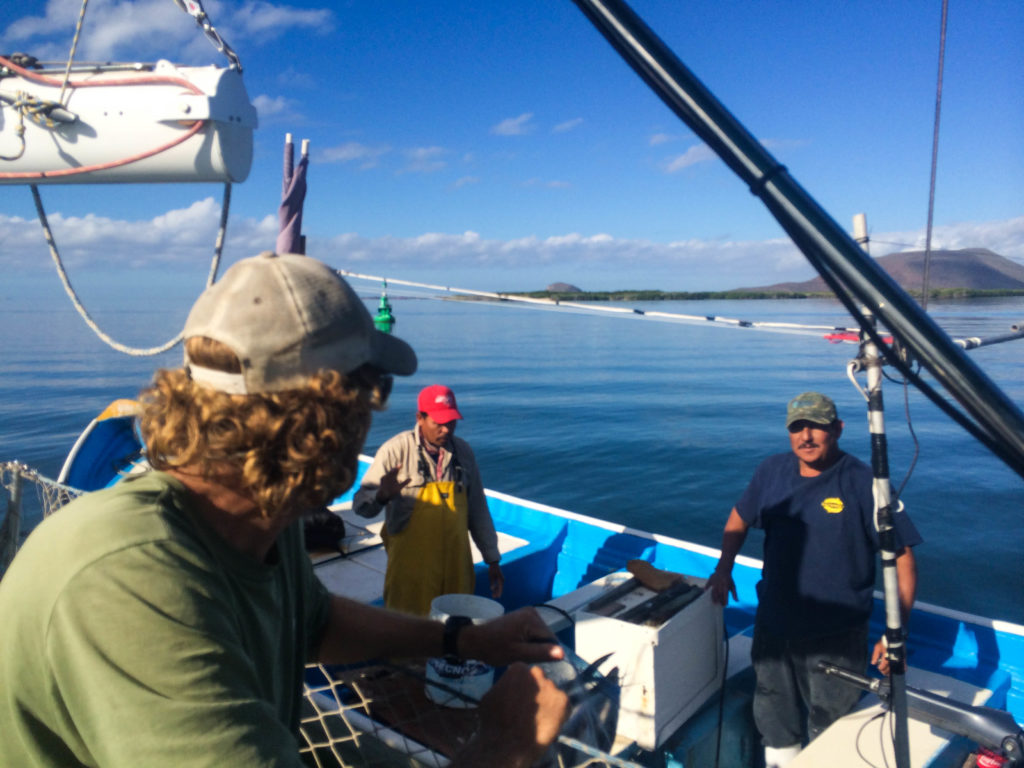
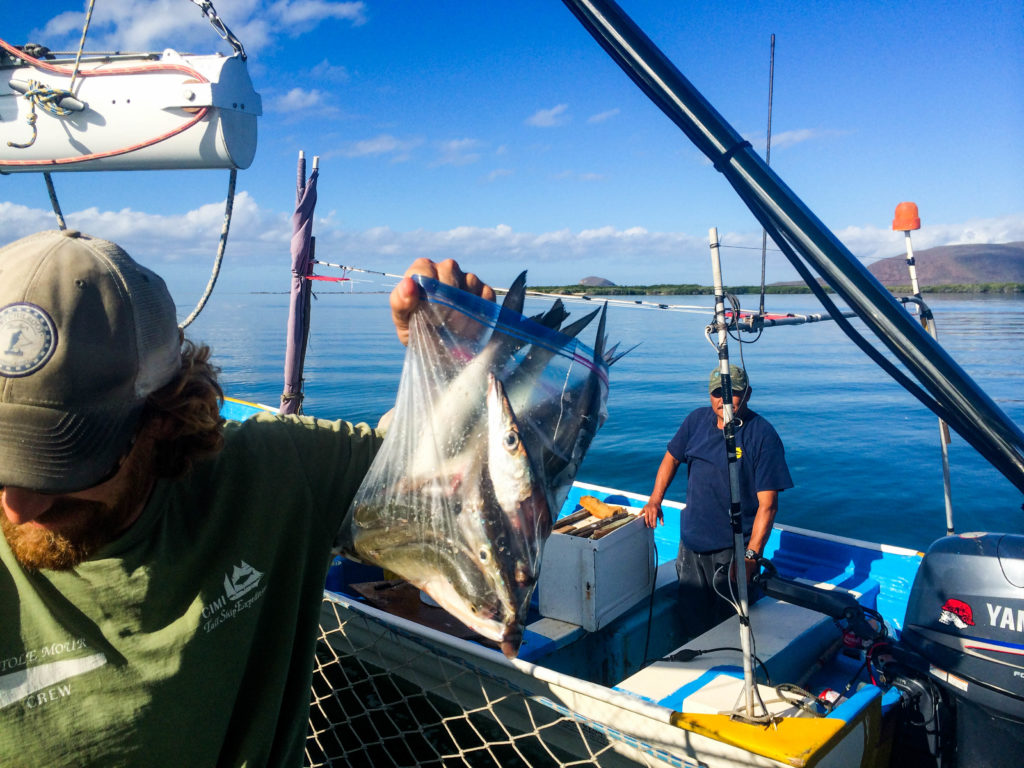
Can’t you stay on this side of town? Callo asked. We want to see the waters of the Ohuira on the other side, I replied. He shook his head sadly, and they motored away over the shallow water outside of the channel, headed home into the late morning sun. Callo watched us from the bow as they disappeared.
[i] I have long since given up on keeping the hull of our boat unmarked. Although the fishermen always attempt not to collide with our crisp white hull, we inevitably hear the rub of two fiberglass boats and find colorful marks and nicks in our hull. Many sailors would sneer—but I like them. They are the proud badges of our research. I think they bring Oleada a little closer to local life on the sea—and make me less persnickety.

